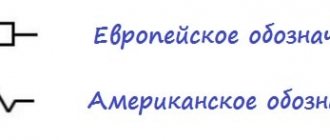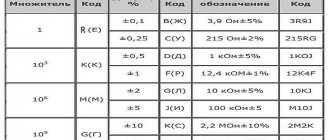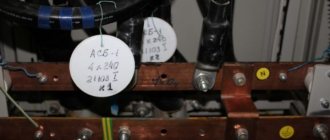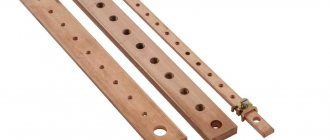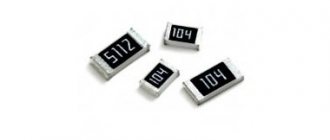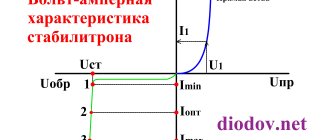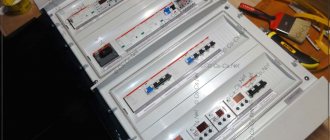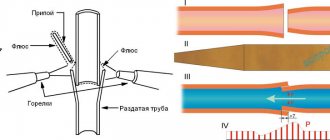After electrical installation is completed, the issues of ensuring the safety and protection of the connection during further operation of the wiring become a priority. In the process of laying electrical networks, special attention must be paid to compliance with technology and quality standards when laying and connecting cables, because these sections of electrical wiring are the most vulnerable. To prevent burnout and emergency situations, insulation and heat-shrinkable tubing of different categories are used.
Heat-shrinkable tubing is an elastic product made of thermopolymer material that is subject to heat shrinking. That is, the length and diameter are affected by temperature; the source of temperature can be hot water, air or fire.
A distinctive feature of the tubes is the increased transverse compression value compared to the longitudinal compression. This means that the diameter of the heat-shrinkable tube can decrease several times (from 2 to 6), and the maximum increase in length is 20%.
General information and scope of application of heat shrink tube
The production of heat-shrinkable tubes at the plant is carried out from a special heat-shrinkable material, which changes dimensions several times depending on the degree of temperature increase. The product is influenced by the surrounding elements - water, flame, air. If one end is heated, the dimensions of the heat shrink tube will increase only in this area, and the other end will remain in the same size range. As the diameter decreases, there is a proportional increase in the thickness of the thermopolymer walls, as a result of which the insulating characteristics of the heat-shrinkable tube for insulating electrical wiring also increase.
Heat shrink tubing HERE is capable of shrinking in size under the influence of temperature and tightening around the wire. HERE is used in the following areas:
- performing electrical installation work to ensure reliable electrical insulation. Heat shrinkage has many advantages over conventional electrical tape, especially when there are a large number of connections;
- marking of cables and electrical wiring - in this case, heat-shrinkable tubes are used as cambrics;
- providing anti-corrosion protection of connections in many areas;
- a means to ensure the mechanical stability of operating mechanisms. Thus, heat-shrinkable tubes are often used on conveyor rollers and rollers;
- In production, thermotubes provide reliable protection of connections from the aggressive effects of external factors, including precipitation.
Properties
All the working properties of heat-shrinkable tubes are manifested thanks to the thermopolymers from which they are made. Under the influence of elevated temperatures, they can be easily heat-shrinkable, that is, they change their shape - they shrink or expand. That is, it is enough to put the pipe on some object and heat it with a special hairdryer or a regular lighter. As a result, its size will instantly decrease, and shrinking, it will tightly fit the object. The most important thing is to prevent overheating, otherwise bubbles will appear in the tube and it will lose its physical properties.
Radiation and chemical effects on the polymer during the production process lead to the release of hydrogen atoms and the fusion of molecules of the polymer substance. This results in a durable, cross-linked material with increased thermal stability. When heated, it becomes more elastic, but does not melt, but simply changes its shape. After heating, a correctly selected material acquires a so-called shape memory, with the help of which the configuration is restored after reheating.
Thus, the main properties of heat-shrinkable tubes are the ability to change thickness and diameter, the ability to work in a wide temperature range, and their coloring in various colors. The latter property allows the products to be used as markings of wires and cables during installation. To control the quality of connections, electrical engineers often use transparent heat-shrinkable tubing.
Advantages and disadvantages
Heat-shrinkable tube has the following advantages:
- due to its tight fit, it does not move under mechanical influence;
- Using and installing heat shrink tubing is a simple task that you can easily do yourself;
- large selection of materials and diameters of heat shrink tube;
- after shrinking, the heat-shrinkable tube HERE acquires additional strength and rigidity at the connection point;
- When choosing which is better - heat shrink or electrical tape, heat shrink definitely has advantages in terms of technical characteristics and a longer service life.
DIY installation
To properly install the tube, you must adhere to a number of rules. At the preliminary stage, perform the following actions:
- Select the appropriate size and brand of heat shrink tube.
- Determined by the amount of material.
- Study the available offers on the market.
- Prepare the working tool.
Note! The choice of tool is especially important, since for different brands of heat shrink the difference in operating temperature can be more than a hundred degrees.
The following tools can be used to install the tube:
- construction hair dryer;
- heat gun;
- portable gas burner;
- gas soldering iron;
- propane torch;
- infrared burner.
Installation of heat shrinkage is carried out in the following sequence:
- Dirt, dust and any foreign particles are removed from the conductors.
- The heat shrink is cut into pieces of the required length.
- Next, the prepared section of heat shrink must be put on the entire wire.
- Using a hair dryer, torch or soldering iron, heat the heat shrink.
The best equipment option for installing heat shrink is a heat gun. It is possible to set the desired shrinkage temperature, which facilitates the installation process.
The heating and installation operation is carried out according to the following algorithm:
- Tubes with a large cross-section are first heated to 50% of the nominal temperature required for shrinkage. The same applies to wide flexible tapes. Heat shrinks with thin walls or small diameters do not require preheating.
- Cut the required length of the tube using regular scissors. You need to cut carefully so as not to leave any unevenness on the edges of the product.
- The tube is slightly stretched and put on the desired area.
- Heat the heat shrink to the nominal temperature using a heat gun or other heating tool. The temperature must not be exceeded, as in this case the surface will be deformed.
- After heating, you need to let the material cool. At this time, no mechanical influences should be exerted on the structure.
Some useful tips for installing heat shrink tubing:
- In the case of heat shrinks of large length or diameter, it is better to start heating from the middle part of the product. Next, the burner is moved towards the edges.
- If it is unclear whether the length of the tube is sufficient, it is recommended to start warming up from the end of the product where the communication plug, wire tip, etc. is installed.
- If heat shrink is installed on a metal base with high thermal conductivity, this surface must be thoroughly heated before installation.
- There should be no sharp edges on the surface to be coated.
- There is no point in stretching heat shrink tubing that is not long enough. The consequence of such actions will be the loss of heat shrink strength and dielectric properties.
Types of heat shrinkage
Types of thermopolymer heat-shrinkable tubes HERE are distinguished based on the production method and the material used:
- polyolefin. They are made from chemically or radiation-glued polyethylene, to which dyes, components to impart plasticity, and fire-fighting substances are added. Most tubes are manufactured using this method; they are designed for a temperature range from -50 to 125 degrees. The material is also resistant to benzene and oxidizing agents during short-term contact;
- elastomers based on synthetic rubber. A characteristic difference is resistance to temperatures up to 175 degrees and the presence of oil and petrol resistant properties, however the price is often too high, which hinders the growth of popularity;
- heat shrink for wires made of thermoplastic polyvinyl chloride. The material provides a high level of insulation, but a small operating temperature range from -20 to 80 degrees;
- polyester has a high level of chemical resistance and resistance to mechanical damage. The material is ideal for the manufacture of thin-walled products;
- fluoropolymer - require complex technological processing, provide unique chemical and physical characteristics;
- products made from silicones are characterized by plasticity and non-toxicity, but are not resistant to organic solvents.
Also classified HERE according to installation method:
- adhesive heat-shrinkable tube, in which a layer of glue is applied on the inside, providing a high degree of tightness and tightness. This type also provides protection against moisture ingress;
- HERE without an adhesive layer for standard connections where there is no need to ensure tightness.
Decorative ones are distinguished by color for an additional decorative effect, and it is recommended to use transparent standard heat shrink in places where it is necessary to check the tightness of the connection.
Depending on the thickness of the walls, they are distinguished: thin, medium and thick walls.
For specific tasks, special types of heat shrink with additional functions are produced, for example, heat shrink with solder, with a corrugated surface, high electrical density, specific cold shrink material and others.
What are heat-shrinkable products made from?
Thermal tubes, in addition to polyethylene, are also made from the following polymer materials:
- synthetic fluorinated rubber (fluorine rubber);
- polymers of the polyolefin group;
- polyvinyl chloride;
- polyvinylidene;
- polytetrafluoroethylene (Teflon);
- polyethylene terephthalate (polyester).
The operating temperature range of heat-shrinkable products also depends on the material (the range is huge: from -60 to +260 degrees).
Characteristics and differences
The main parameters that characterize a heat-shrinkable tube are:
- heat resistance;
- shrinkage coefficient in the range from 200 to 600%;
- diameter of the heat shrink tube before and after exposure to temperature;
- oil resistance;
- chemical inertness;
- ability to withstand voltage up to 1000V;
- petrol resistance;
- resistance to ultraviolet radiation;
- anti-flammability properties;
- shrinkage temperature and operating range.
Products can be produced in round, oval and compressed shapes, which does not affect installation. Note that thin-walled heat-shrinkable tubing is mainly produced in an oval or flattened shape.
Additional tasks to be solved
Thermally shrinkable tubes are used not only for installing wires. This is the ability to create a layer of reliable insulation on wires or tools. For example, in switchboards or electrical appliances you have to unscrew screws with a screwdriver with the risk of touching adjacent live parts. To avoid this, put a heat-shrinkable tube on the tip of the screwdriver of such length that only its tip remains exposed. After heating, it will cover the sting so tightly that the resulting layer can only be removed by cutting it with a knife.
Making a screwdriver with an insulated tip Making a screwdriver with an insulated tip
In order for the tube to shrink optimally, its entire surface must be heated evenly. You can find tubes of different diameters on sale. Large diameter tubes are made folded and flat to occupy less volume. These shrink fittings are good for upgrading metal hand tools. For example, using large diameter tubing, you can renew or insulate the handles of pliers or pliers, wrenches, etc.
Since the range of diameters and colors is very diverse, you can always make a good choice of tube. And if necessary, the thickness of the insulation layer can be increased by a sequential process, putting on and shrinking several tubes. To obtain the most durable attachment of the film to the handle, preventing it from slipping under significant forces, it is best to use tubes with a layer of hot-melt adhesive. Another use for a tube with a layer of hot melt adhesive is to create an anti-corrosion coating on hoses and pipes.
Insulating the handle of a wrench Insulating the handle of a wrench Insulating the handle of a wrench Insulating a small electronic board with heat shrink sleeve Insulating a small electronic board with heat shrink sleeve Insulating a small electronic board with heat shrink sleeve
Diameter before and after
Heat shrink for wires changes its size as the temperature rises. For this reason, the manufacturer's name indicates the size before and after heating. For example, if the name indicates HERE NG 40/20, then 40 mm is the internal diameter before shrinkage, 20 mm after. When connecting cables of different sections and diameters, heat shrinks with large coefficients are required.
The amount of shrinkage must also be taken into account when choosing the length of products. For high-quality tubes, shrinkage along the length is no more than 5-7%, and for Chinese tubes it is about 20%.
When choosing a large-diameter heat-shrinkable tube, you need to pay attention to both shrinkage parameters. The higher the degree of shrinkage, the thicker the walls of the tube become after heating, which as a result significantly increases the density and strength of the connection. Thick-walled products have optimal shrinkage rates.
Installation rules
Let's consider an example of connecting a cable consisting of two 2.5 square wires. The actual diameter of one wire with insulation is 4 mm, the cable diameter is 10 mm.
Important:
When connecting two wires, separate the connection points 3-5 cm from each other. This will avoid a short circuit in the event of a break in the thermal insulation.
This can be done quite simply - you make one wire shorter, the second longer, and vice versa on the other side of the cable. You connect the long one to the short one (the connection is best done with a terminal or soldering twist), the short one to the long one. As a result, you will get two connections separated from each other by several centimeters.
You already know everything you need about the types of heat-shrinkable tubing, so you can choose them yourself. Before twisting the wires, you put heat shrink on each piece. Keep in mind that when heated, it will “shrink” by 7-10 percent.
In our case with 4 mm wires, we take a tube with a diameter of 10 mm, and put a 20 mm shrink on the cable itself. First, we twist the two wires (connect them by color so as not to get confused, that is, brown with brown, blue with blue), then move the heat shrink so that it covers the connection, and heat it with a lighter until it tightly grips the wire.
We repeat the operation with the second one, and then isolate the junction from above with the last thick tube.
It is recommended to warm up either from the middle to the edges, or from one edge to the other. There is no need to first “solder” the two edges and then heat the center - air will accumulate inside, which will prevent the cable from being well insulated.
The tube can take different shapes
The length of the tube should be chosen so as to create 30-50 mm of insulation on each side of the connection. In this case, take into account shrinkage of 10 percent. The thicker the cable, the wider the insulation - our 10 mm can be protected by 5-7 cm in each direction.
When heating the polymer, be careful. There is no need to heat one place for a long time - try to move the lighter over the entire surface, heating it evenly. When the polymer begins to shrink, smooth it out with your fingers - it will not burn the skin. It is necessary to exclude the appearance of air bubbles under the PVC.
If heat shrink with glue is installed on the cable, it is recommended to degrease and clean the surface from dust.
If you are working with the material for the first time, practice on wire scraps. You will understand how to heat correctly, which side to start shrinking from, how to properly level it.
Selection by color
Colored decorative heat shrink tubing is convenient for marking because a small ring of a distinctive color is placed over the insulation at the end of the cable. Here are the basic rules for using colored tubes:
- in the wiring of DC electrical circuits, red is used on the plus and black on the minus;
- on the ground wires - a yellow-green tint;
- in a three-phase electrical circuit - red, yellow and green colors in phases.
Thanks to the wide range of colors, heat-shrinkable tubes can be used as a decorative material.
Offers on the market
There is a wide variety of heat shrink tubing available for sale to suit any need. You can purchase heat shrink in lighting and electrical goods stores, from specialized distributors, in online stores, as well as from power supply organizations. Tubes are offered in coils, rolls or boxes. This product is measured in linear meters.
The table shows prices for individual sizes of heat shrink in online stores as of the first half of 2022.
Heat shrink tubing is the best option for protecting electrical connections. They are indispensable when it is necessary to ensure special reliability and safety of insulation.
We solve difficult questions: what can replace electrical tape?
This question comes up quite often, because traditional insulating tape is not always suitable. A heat-shrinkable tube with certain characteristics will help replace it. For example, it is necessary to connect and protect the wiring through which current flows. It is clear that plasticine is not the best sealant in such a situation, not to mention the fact that using tape is an equally stupid idea.
To work, you will need a thermal gun, the operating mode of which is set in the range from 120 to 200 degrees. Setting the mode to 70-120 degrees, instead of the one indicated above, is necessary when using Chinese-made tubes.
In the future, you need to adhere to the following algorithm:
- Heating always starts from the middle of the joint;
- As it warms up, the heat source is carried out in a circle, except for the corners;
- You need to make sure that the thermal sealant “presses” tightly to the central part of the wire;
- The point of the metal junction gradually heats up;
- After this, you need to gradually heat the two end parts so that after cooling they can quickly restore their original size;
- Give the joint about 2 hours necessary to cool;
- If you can write on the finished product with a washable marker without compromising the strength of the insulating coating, then the work has been done efficiently.
How to use cambric
Under ideal operating conditions, cambrics shrink in several ways.
Construction hair dryer
Heat-shrinkable cambric is much more convenient to use than electrical tape.
The device produces a stream of hot air (200-300 degrees), which heats the heat tube. For precise direction of the jet, you can use a special nozzle. The connection will cool down and be solid in 30-40 seconds.
Soldering iron
The heating element is used as an alternative to a hair dryer. To shrink the diameter, you need to walk the soldering iron casing over its surface. You cannot work with a sting:
- traces of soot will remain on the surface;
- the sting will get dirty;
- the cambric will melt at temperatures above 300 degrees.
Solder is not used to shrink the heat tube.
Scope of application of the device
Heat-shrinkable tubes are characterized by a high degree of elasticity, resistance to various negative environmental factors, and increased tensile strength, due to which they are actively used for:
- insulation of the current-carrying zone of wires and functioning units under voltage;
- providing protection at the connection points of cable lines or conductors;
- fastening lugs for connecting purposes and couplings on the cable;
- designing markings on wires;
- hermetically sealed protection of cable bundles in the longitudinal direction with a special heat-shrinkable tape;
- preventing violations of the integrity of wires under the influence of the temperature factor;
- ensuring ergonomic handles on equipment and creating conditions for safe operation of various tools.
Protecting exposed wires
Having understood the basics, you can move on to the practical part of preserving electrical wiring from external influences. We are talking not only about water, but also about dampness, accidental damage and even pets.
All traces of dirt are removed from the surface of the wires. This is done using delicate cleaning products.
The further procedure is as follows:
- Electrical wires are degreased using a solvent;
- Wipe them gently with a soft cloth;
- If the electrical wiring is covered with PVC insulation, it must be removed using mild sandpaper;
- Using a lighter will help remove the polyethylene insulation materials.
Before starting work, you should clean the wires from traces of grease, dirt and the oldest insulation. This is done with a lighter or not very rough sandpaper. As soon as the wires are free of coating, you can begin to work.
Difference in materials
For the manufacture of heat shrinkage, different types of materials can be used. As a result, the final product will have slightly different characteristics.
What are cambrics used for in electrical engineering?
Marking of current-carrying conductors
The purpose of the tube is to insulate the electrical network, since the connection must be closed using welding, bolts, soldering, sleeves or terminal lugs. The cambrics are put on the products, then the edges are covered with electrical tape. The free edge is heated and pressed with pliers.
Thermocembric, in addition to its intended purpose, is used in the following cases:
- restoration of the insulating layer of wiring with direct and alternating current;
- contact markings – other colors are clearly visible on the white tube;
- ensuring cable protection from breaks or damage;
- masking connection points when installing electrical wiring;
- additional insulation of substation areas;
- preventing the edges of a printed circuit board from contacting each other.
Anglers use cambric to secure floats and hooks or even as bait.
